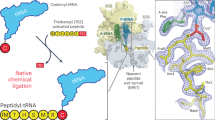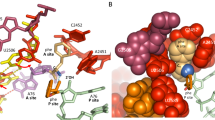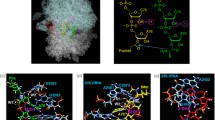Summary
The properties of the ribosomal elongation cycle were analyzed in the extreme halophilic archaebacterium Halobacterium halobium under conditions optimal for poly(U)-dependent poly(Phe) synthesis (60 mM Mg2+, 6.4 M monovalent cations). For tRNA binding studies the standard nitrocellulose-filter technique could not be used, since due to the high salt concentration the nucleic acids were retained quantitatively on the filters. Instead, an ultracentrifugation technique was applied, which revealed in saturation experiments that the following numbers of tRNA molecules could be bound per poly(U) programmed ribosome: (a) three deacylated tRNAPhe molecules, or (b) two Phe-tRNAPhe molecules in the A and P sites, or (c) one AcPhe-tRNAPhe molecule in either the A or P site (exclusion principle). In the absence of poly(U), AcPhe-tRNAPhe and deacylated tRNAPhe bound exclusively to the P site, whereas a low but significant binding of Phe-tRNAPhe to the A site was observed. Functional analyses were performed with ribosomes carrying a deacylated [14C]tRNA in the P site and a peptidyl-tRNA in the A site. The results demonstrate that the translocation reaction is not accompanied by a release of deacylated tRNA, but that the deacylated [14C]tRNA is released in the subsequent round of elongation.
These data are qualitatively identical to those recently reported with E. coli ribosomes, although here different methods under extreme conditions had to be applied. This convincingly indicates the general validity of the three-site model for the description of the ribosomal elongation cycle in eu- and archaebacteria.
Similar content being viewed by others
Abbreviations
- A site:
-
aminoacyl-tRNA site
- P site:
-
peptidyl-tRNA site
- E site:
-
exit site for deacylated tRNA
- AcPhe-tRNAPhe :
-
N-acetyl Phe-tRNAPhe
- [3H↓]Phe and [3H↑]Phe:
-
[3H]phenyl-alanine with a low and high specific activity, respectively (activities are different by a factor of 30)
References
Grajevskaja RA, Ivanov YV, Saminsky EM (1982) 70 S ribosomes of Escherichia coli have an additional site for deacylated tRNA binding. Eur J Biochem 128:47–52
de Groot N, Panet A, Lapidot Y (1971) The binding of purified Phe-tRNA and peptidyl-tRNAPhe to Escherichia coli ribosomes. Eur J Biochem 23:523–527
Kirillov SV, Makarov EM, Semenkov YP (1983) Quantitative study of interaction of deacylated tRNA with Escherichia coli ribosomes: Role of the 50 S subunits in formation of the E site. FEBS Lett 157:91–94
Leder P (1973) The elongation reactions in protein synthesis. Adv Prot Chem 27:213–242
Lill R, Robertson JM, Wintermeyer W (1984) tRNA binding sites of ribosomes from Escherichia coli. Biochemistry 23:6710–6717
Rheinberger H-J, Nierhaus KH (1983) Testing an alternative model for the ribosomal peptide elongation cycle. Proc Natl Acad Sci USA 80:4213–4217
Rheinberger H-J, Schilling S, Nierhaus KH (1983) The ribosomal elongation cycle: tRNA binding, translocation and tRNA release. Eur J Biochem 134:421–428
Rheinberger H-J, Sternbach H, Nierhaus KH (1981) Three tRNA binding sites on Escherichia coli ribosomes. Proc Natl Acad Sci USA 78:5310–5314
Saruyama H, Nierhaus KH (1985) A highly efficient poly(U) dependent poly(Phe) synthesis system for the extreme halophile archaebacterium Halobacterium halobium. FEBS Lett 183:390–394
Visentin LP, Chow C, Matheson AT, Yaguchi M, Rollin F (1972) Halobacterium cutirubrum ribosomes: Properties of the ribosomal proteins and ribonucleic acid. Biochem J 130:103–110
Watanabe S (1982) Interaction of siomycin with the acceptor site of Escherichia coli ribosomes. J Mol Biol 67:443–457
Wurmbach P, Nierhaus KH (1983) The inhibition pattern of antibiotics on the extent and accuracy of tRNA binding to the ribosome and their effect on the subsequent steps in chain elongation. Eur J Biochem 130:9–12
Author information
Authors and Affiliations
Additional information
Communicated by A. Böck
Rights and permissions
About this article
Cite this article
Saruyama, H., Nierhaus, K.H. Evidence that the three-site model for the ribosomal elongation cycle is also valid in the archaebacterium Halobacterium halobium . Molec. Gen. Genet. 204, 221–228 (1986). https://doi.org/10.1007/BF00425502
Received:
Issue Date:
DOI: https://doi.org/10.1007/BF00425502




